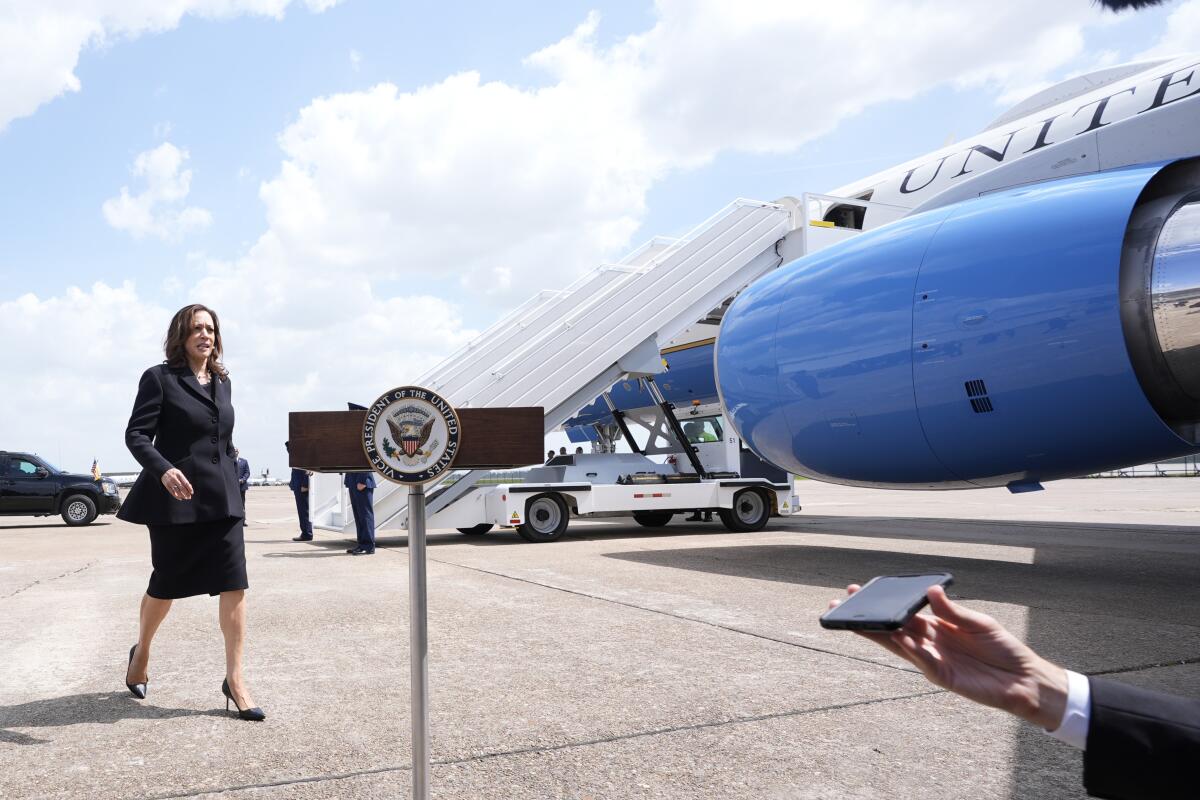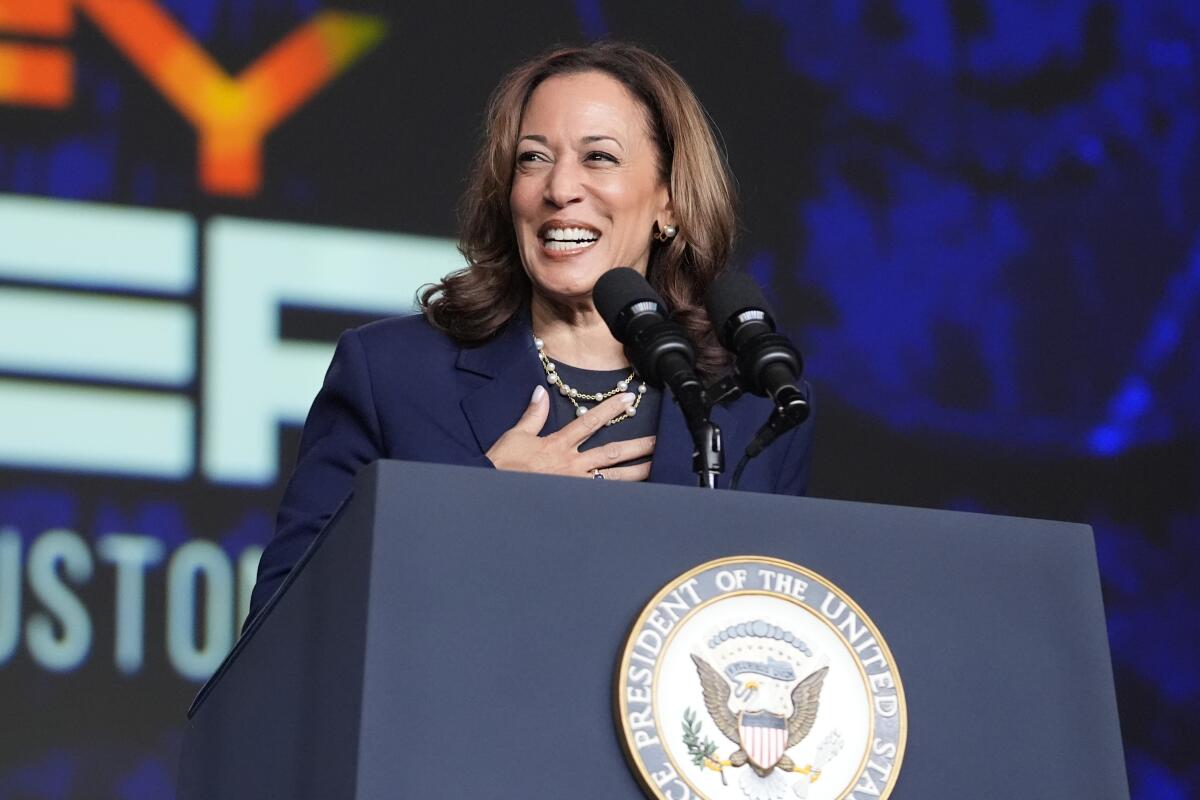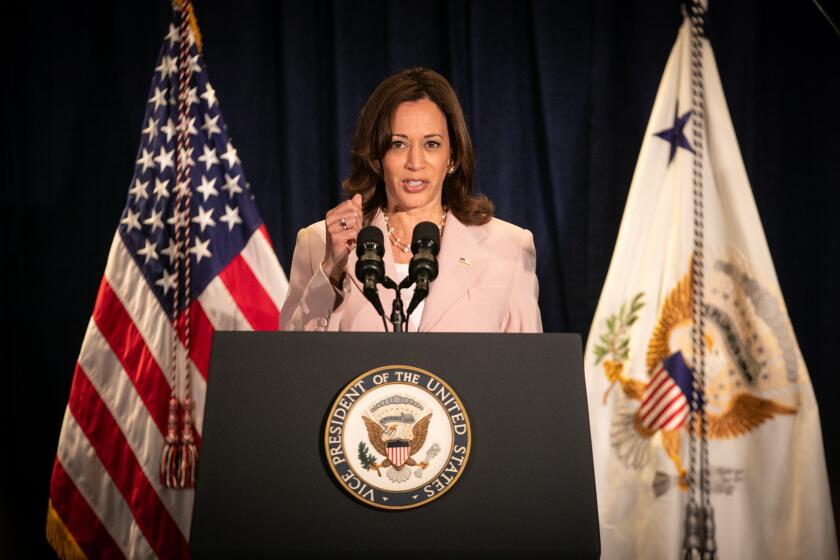Hold the ‘blue wall,’ or light up the Sun Belt? Harris eyes path through U.S. battlegrounds

- Share via
Vice President Kamala Harris’ late entry into the presidential race against former President Trump reset the political playing field in important ways, giving Democrats a promising boost in polling and a huge infusion of cash and volunteers. But it didn’t change everything.
In a nation of more than 330 million people, the 2024 election — just like the 2016 and 2020 elections before it — will almost certainly be decided by a relatively small number of voters in a handful of battleground states, political experts said.
When Hillary Clinton lost to Trump in 2016, it was by fewer than 80,000 votes across Wisconsin, Michigan and Pennsylvania combined. When President Biden beat Trump in 2020, it was by fewer than 50,000 votes across Wisconsin, Arizona and Georgia.
Now, Harris is in a high-speed race to start executing her own path to victory through the nation’s battlegrounds, which include Pennsylvania, Michigan and Wisconsin — three of the “blue wall” of states that lean Democratic — and Georgia, North Carolina and Arizona, in the nation’s Sun Belt. This week, she is expected to pick her running mate — possibly from one of those states — and begin holding major rallies in places such as Philadelphia, Detroit, Raleigh, N.C., and Savannah, Ga.
Amid the high-stakes number-crunching that campaigns always do to determine their best path to victory, the Harris campaign is citing polls showing her closing the gap with Trump in nearly every battleground, and seeming more bullish than Biden’s campaign ever did. On the question of whether Harris might focus on the blue wall or the Sun Belt, her campaign’s answer has been both.

In a call with reporters last week, the campaign’s battleground states director, Dan Kanninen, said the flood of support for Harris across the country included 360,000 new volunteers and $200 million in donations during the first week of her candidacy — two-thirds of which was from new donors.
On Friday, the Harris campaign said that it had $377 million in cash on hand — compared with $327 million for Trump — and that it would be spending hard and fast to ramp up the fight.
In a tumultuous stretch of the 2024 presidential campaign, donors contributed hundreds of millions of dollars to Vice President Harris and former President Trump.
Kanninen said the campaign is rapidly expanding an already large network of Biden-Harris field offices and volunteers across the battleground states. He said that there were 600 staffers “on the ground in the blue wall,” and that 150 more would be added by mid-August. Aides also planned to double the size of the campaign’s teams in Arizona and North Carolina, and were opening new field offices in Georgia.
Volunteers were fanning out to knock on doors, and being trained on how best to spur pro-Harris conversations online.
“We’re making these investments across the entire map because the data is clear: We have multiple pathways to 270 electoral votes,” Kanninen said. “The vice president is strong in both the blue wall and in the Sun Belt, and we are running hard in both.”
The Trump campaign did not respond to a request for comment on its strategy for battleground states.
In the American electoral system, voters cast ballots to elect the president, but the candidate who receives the most votes nationally is not necessarily the winner. Clinton, for example, received about 2.9 million more votes than Trump, and still lost.
That’s because the candidate who wins the most individual votes in a state receives all of that state’s electoral votes, in what’s known as the electoral college. The number of electoral votes per state is determined by population, with the most populous states — such as California — receiving the most.
In order to win an election today, a presidential candidate must secure 270 electoral votes, and different presidents have gotten there through different pathways. Barack Obama famously pulled together a broad coalition of voters, flipping nine previously red states to blue in 2008.
Clinton was confident going into the 2016 election, riding polls that appeared strongly in her favor, only to have her campaign’s swing-state strategy — she never campaigned in Wisconsin — ridiculed by some political analysts after her stunning defeat. In 2020, Biden managed to undo some of the damage to the Democratic Party, taking back several key battleground states while flipping Arizona and Georgia — but by closer margins and via a narrower path to victory than Obama‘s in 2008 and 2012.
Political experts, pollsters and other veterans of presidential races said that given Harris’ resources, it makes sense for the campaign to cast a wide net and fight in as many swing states as possible. But they have different takes on how she might get to 270 — or fall short.
Robert Alexander, a professor of political science at Bowling Green State University in Ohio and author of “Representation and the Electoral College,” has long studied presidential paths to victory on the electoral map.
“Harris’ entry has changed the complexion of states up for grabs, I would say, from where Biden was — and it’s made it more amenable for Democrats. Certain states seemed to be slipping away [under Biden], and some of the early polling would say that they are now back in grasp for a Harris-led ticket,” Alexander said. “That’s a pretty significant shift in a pretty quick time period.”
He said that Pennsylvania — with 19 electoral votes, which Clinton lost and Biden won — is a “pretty key state in all of this right now,” and that there will no doubt be “money dumped” into campaigning there.
But he also expects Harris, buoyed by new energy and enthusiasm, to invest in driving up turnout in the South, in part to force Trump — who had been preparing to “run up the scoreboard” on Biden — back into a defensive posture.
Kyle Kondik, a political analyst at the Center for Politics at the University of Virginia, said both Harris and Trump appear focused, correctly, on the seven states that were decided by 3 percentage points or less in the last election: Pennsylvania, Michigan and Wisconsin in the blue wall; Georgia, North Carolina and Arizona in the Sun Belt; and Nevada.
In 2020, Biden won six out of the seven, while Trump took North Carolina — and all of them are up for grabs in 2024, Kondik said.
Before Biden dropped out, Kondik had been watching the president’s numbers falling fast in the blue wall swing states, and considered the decline a deadly sign for the Biden campaign. “If he lost in any of them, he wasn’t going to win,” Kondik said.
He said the same probably holds true for Harris, but that may change if her numbers keep going up in North Carolina and Georgia.
“The jury’s out on that,” he said.

Cornell Belcher, a pollster who worked for both Obama campaigns, said Harris may not be able to restore Obama’s broad coalition. But it “makes all the sense in the world” for her to follow Obama’s strategy of “pressing for expansion” on the electoral map, he said — “going more places and making Republicans play defense more.”
Harris has to “secure the blue wall, hard stop,” Belcher said, and will definitely be paying attention to — and spending time in — Wisconsin, Michigan and Pennsylvania.
But given her brimming campaign coffers, he said, she also has the “opportunity to go on the offensive” in other vulnerable places.
Simone Biles, who has won gold twice at the Paris Olympics, weighs in on former President Trump’s controversial comments about immigrants taking ‘Black jobs.’
North Carolina, which Obama had flipped blue, more recently elected a Democratic governor in Roy Cooper, and may see diminished Republican turnout given GOP primary voters’ selection of far-right candidates in down-ballot races, Belcher said.
“It’s absolutely an opportunity if you have the resources,” he said of the Harris campaign. “And again, they have the resources.”
Georgia, he said, is also in play, with a “well-educated, upwardly mobile population and a growing segment of minority voters” who flipped both of the state’s U.S. Senate seats blue in the last election.
“For Democrats to not tap in to these changing dynamics within these states,” Belcher said, “would be malpractice.”
Harris doesn’t have a lot of time, but Belcher and others said it’s unclear how relevant that is. This race has been moving at lightning speed, the trajectory of polling in several states turned on a dime in the last couple of weeks, and Harris’ favorability ratings shot up in record time after Biden endorsed her.
“We’re in uncharted waters,” Belcher said. “There are no road maps for all of this.”
Alexander, of Bowling Green, said he still believes that Harris has a “tougher path” to winning than Trump due to the nature of the electoral college system — and he worries 2024 could be another “misfire election,” with Trump winning the electoral college despite Harris winning the popular vote.
“In a different time,” Alexander said, “it would be seen as a constitutional crisis.”
More to Read
Get the L.A. Times Politics newsletter
Deeply reported insights into legislation, politics and policy from Sacramento, Washington and beyond. In your inbox twice per week.
You may occasionally receive promotional content from the Los Angeles Times.












